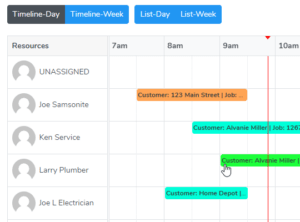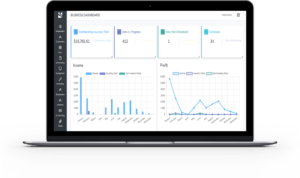In the competitive world of field service, maximizing billable hours is essential for a company's growth and profitability. In this guide, we will look at ways to make the most of billable hours. This includes tracking time, scheduling, using technology, training, and analyzing performance indicators.
Table of Contents
- The Importance of Billable Hours in Field Service
- Effective Time Tracking Strategies
- Optimizing Scheduling and Dispatching
- How to Determine Price of Labor
- Leveraging Technology to Enhance Productivity
- Training and Employee Development
- Analyzing and Improving Key Performance Indicators (KPIs)
- Conclusion
The Importance of Billable Hours
Billable hours are a critical aspect of a company's revenue and overall success. These hours represent the time that technicians performing billable work for clients. Ensuring efficient use of this time is vital for increasing profits, improving customer satisfaction, and driving business growth.
Effective Time Tracking Strategies
Implement a Consistent Time Tracking System
Implement easy-to-use time tracking software to ensure accurate recording of billable hours. This system should be easy for all employees to use and have project codes, descriptions, and automatic timers.
Establish Clear Time Tracking Policies
Develop and enforce clear time tracking policies that outline the process and expectations for recording billable hours. This includes defining billable and non-billable activities and setting guidelines for time tracking accuracy.
Regularly Review and Audit Time Entries
Conduct periodic reviews of time entries to ensure accuracy, identify discrepancies, and address any issues promptly. This helps maintain the integrity of tracking time and promotes accountability among employees.
Optimizing Scheduling and Dispatching
Implement a Scheduling System
A dynamic scheduling system enables real-time adjustments to technician schedules, ensuring efficient allocation of resources. This system should consider factors such as technician availability, skill sets, and geographic location.

Plan for Contingencies
Account for potential contingencies, such as traffic delays, equipment breakdowns, or unexpected job complications, when scheduling service appointments. This helps minimize disruptions to the schedule and ensures that we maximize calculated billable hours.
Utilize Route Optimization Software
Implement route optimization software to streamline technician travel between job sites. By reducing travel time, technicians can spend more time on billable activities, thereby increasing overall productivity.
How to Determine Price of Labor
Understanding labor and costs are crucial for making informed decisions related to pricing, resource allocation, and overall business strategy. In this section, we will outline the steps to determine labor effectively. For a deeper dive, visit our article on how to calculate your labor rates
Identify Direct Cost for Labor
Direct cost from labor are the wages and salaries paid to employees for their time spent on billable tasks. To calculate costs, consider the following components:
- Hourly wages or salaries of technicians
- Overtime pay, if applicable
- Bonuses or commissions tied to performance
Factor in Indirect Costs from Labor
Costs from labor that are indirect include the expenses associated with employee benefits, training, and administrative tasks. These costs do not directly depend on the number of billable hours but are essential for overall operations. Common costs include:
- Employee benefits, e.g., health insurance, retirement plans and paid time off
- Training and professional development costs
- Administrative tasks, such as scheduling, dispatching, and payroll processing
Calculate Total Labor Costs
Combine both direct and indirect labor costs to determine the total labor cost for your operations. This can be calculated as follows:
Total Labor Cost = Direct Labor Costs + Indirect Labor Costs
Determine Labor Cost per Technician
To gain a better understanding of costs on an individual level, calculate the cost per technician. This can help identify any discrepancies or inefficiencies in resource allocation. Calculate the cost for labor per technician as follows:
Labor Cost per Technician = Total Labor Cost / Number of Technicians
Monitor and Adjust Costs from Labor as Needed
Regularly review and analyze costs to identify trends and areas for improvement. Adjust your work based on industry standards, technician skills, and changes in benefits or wages for employees.
Leveraging Technology to Enhance Productivity
Employ Software
Field service management software can automate various aspects of the job, such as scheduling, invoicing, and reporting. By streamlining these processes, technicians can focus more on billable tasks and improve overall efficiency.
Embrace Mobile Technology
Equip technicians with mobile devices and apps that provide real-time access to job information, customer data, and other essential resources. This enables technicians to work more efficiently and effectively while on site.

Integrate IoT and Remote Monitoring Solutions
Use IoT and remote monitoring to collect live data on equipment performance. This helps with maintenance and reduces the need for in-person visits. This enhances technician productivity and enables them to focus on billable tasks with higher priority.
Training and Employee Development
Invest in Skill Development
Invest in ongoing training and skill development for your technicians. This ensures that they have the latest industry knowledge, which enables them to work more efficiently and effectively.
Provide Soft Skills Training
In addition to technical skills, emphasize the importance of soft skills such as communication, problem-solving, and customer service. This helps improve customer satisfaction and can lead to increased repeat business and referrals.
Encourage Continuous Learning
Promote a culture of continuous learning within your organization. Provide resources and opportunities for employees to learn and grow, such as training courses, seminars, and certifications. This not only improves the quality of work but also increases employee engagement and job satisfaction.
Analyzing and Improving Key Performance Indicators (KPIs)
Track Relevant KPIs
Identify and track relevant KPIs, such as billable hours, revenue per technician, and first-time fix rate. Regularly monitoring these metrics provides valuable insights into your company's performance and can help identify areas for improvement.

Set Performance Benchmarks
Establish performance benchmarks for your team based on industry standards and best practices. This helps set clear expectations and enables you to measure progress toward achieving your business goals.
Implement Data-Driven Decision Making
Use the insights gained from KPI analysis to make informed decisions about resource allocation, technician scheduling, and process improvements. Data-driven decision making ensures that your organization remains agile and adaptive to changing market conditions.
Conclusion
Maximizing billable hours in the field service industry is essential for driving growth and profits for small businesses. Improve productivity and beat competitors by tracking time, scheduling efficiently, using technology, training employees, and analyzing performance indicators in your organization.

